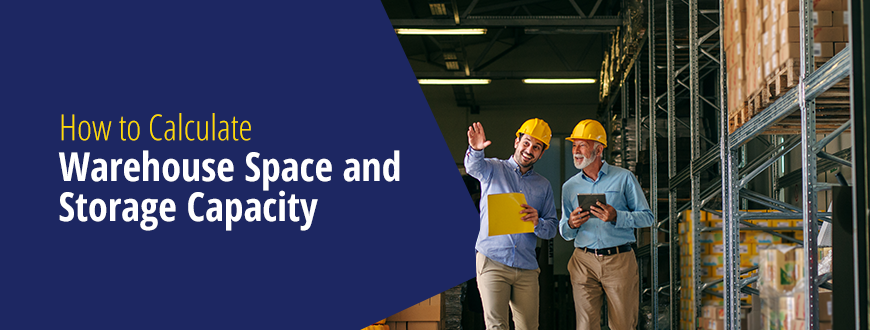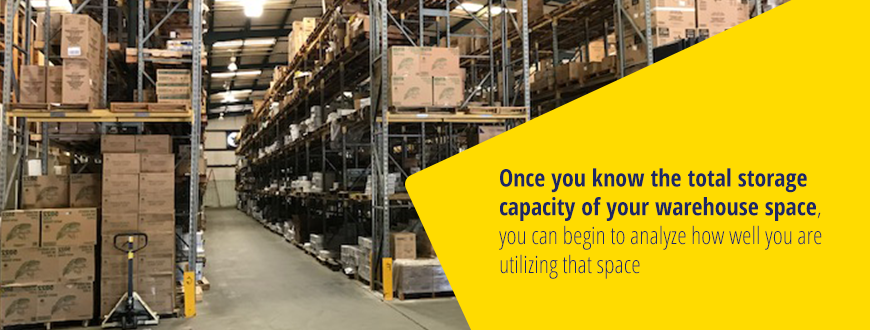How to Calculate Warehouse Space and Storage Capacity

In warehouses and other storage facilities, space is arguably the most valuable asset. By making the best use of their warehouse space, businesses can significantly increase the amount of product they can store in the facility. By being able to store more items at once, they can save money on transportation costs and other expenses. Plus, it allows the staff better access to products, thus allowing them to fulfill orders faster and ultimately get products to the customer sooner. Because of how precious space is in a warehouse setting, warehouse managers and business owners should take the time to calculate how much space they have and how well they’re utilizing it. In this article, we’ll discuss how to make those calculations and improve how you’re using your warehouse’s available storage space.
Calculating the Total Storage Capacity of Your Warehouse
To figure out how well you’re using your warehouse storage space, you first need to calculate the total storage capacity of the building. A common mistake is merely calculating the square footage of the entire facility and leaving it at that. This number, however, does not account for space within the building that cannot be used for product storage. For this reason, you have to take a few additional steps to reach an accurate number for your warehouse’s total storage capacity. Follow these four steps:
- Calculate the complete square footage of your warehouse. Let’s say it’s 100,000 square feet.
- Subtract the total square footage of space that is used for non-storage purposes. This should include any office space, bathrooms, loading areas and other space where you cannot store goods. Let’s say that calculation comes out to 20,000 square feet. So, your warehouse has 80,000 square feet of usable space.
- Determine your building’s clear height, which is the distance from the floor to an overhead object. For most buildings, this would be the distance from the floor to the facility’s steel shell, but it could also be the distance from the floor to the lowest-hanging overhead objects, such as lighting or equipment. Your building’s clear height will impact your usable space because it dictates how high up you can store items.
- Multiply your total square footage of usable space (80,000) by your facility’s clear height to determine your warehouse’s storage capacity in cubic feet. Going with our example, if your building’s clear height is 25 feet, it has a total storage capacity of 2,000,000 cubic feet.
The reason you must convert your warehouse’s total storage capacity into cubic feet is because it makes it easier to analyze how well you’re using that space, as you can also calculate your warehouse storage utilization in terms of cubic feet.
Are You Utilizing All of Your Warehouse Space?
Once you know the total storage capacity of your warehouse space, you can begin to analyze how well you are utilizing that space. You can do this in two steps — learning how to calculate warehouse space utilization and then analyzing your individual usage. 
1. Learn How to Calculate Warehouse Space Utilization
Calculating your warehouse space utilization will help you make sure you’re as efficient as possible with the available space at your facility. This number represents the percentage of your usable storage space that you’re using. Believe it or not, you don’t want this number to be a perfect 100% — in fact, you want it to be much lower than that. We’ll explain why after going over the calculation. Going back to our previous example, we know the total storage capacity of the warehouse is 2,000,000 cubic feet. To determine how much of that space you’re actually using, you’ll need to calculate the inventory cube size of your facility. Follow these steps to calculate the inventory cube size of your warehouse:
- Measure the footprints of all your pallet racks.
- Calculate their total vertical storage capacity.
- Multiply the true capacity of each of the pallet racks in your warehouse by the total number of racks you have.
The number you reach after making those calculations represents the size of your warehouse’s storage cube. Let’s say the number you landed on after doing this math is 500,000. With your total storage space being 2,000,000, that means your storage utilization percentage would be 25% — which is pretty good.
2. Start Evaluating Your Warehouse Space Utilization
Some of you may be wondering: “Why is 25% a good utilization percentage? Shouldn’t it be closer to full capacity?” The short answer is no. Instead, having a storage utilization that is more than 27% or less than 22% would signal a potential issue in the layout and design of your warehouse. A utilization percentage of more than 27% would likely mean your staff is having a difficult time moving around the warehouse to pick and restock items, which would result in high labor expenses. On the other hand, a storage cube size that is less than 22% of your facility’s total storage capacity would indicate that you may be wasting potential storage space due to the layout of your warehouse. If we’re still working with the warehouse that has 2,000,000 cubic feet of usable storage space, that would mean a storage cube of between 440,000 and 540,000 would be ideal. So, let’s take the middle of that range — 490,000 — and say that’s the storage cube size to aim for to achieve the optimal warehouse storage efficiency. This number, of course, will vary for every warehouse. But for the sake of this example, let’s say this particular warehouse has a 490,000 storage cube size. Warehouse managers and designers can then lay out the facility with optimization and efficiency in mind, and you can calculate how much of that storage cube size you are actually utilizing. If you are storing 350,000 of product, you would be using 71.42% of the optimal storage space that is available.
Contact T.P. Supply to get Everything you Need!
Once you have calculated what you need in your warehouse, contact T.P.Supply or give us a quick call if you have any questions or need to order supplies for your warehouse! If you want more information on how to maximize your warehouse capacity, click here!


